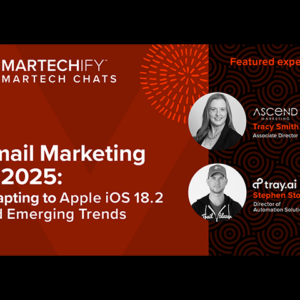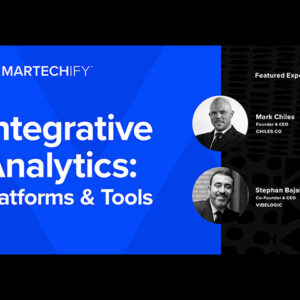Session Recap
Martech: Delivering Next-Level Content Marketing
October 6, 2022 — During this Martechify discussion, four of our martech and content experts discussed approaches, best practices, and tools for upleveling content including using personalization.
In this session, Marie Martin of AxleHire, Penny Hill of Khoros, Stephanie McArthur of Demandbase, and J.P. Maxwell of Tipit explain how to uplevel your content game by getting the right content to the right person at the right time with the help of martech tools including CRMs ( Marketing Automation Platforms), CDPs (Customer Data Platforms), ABM Platforms (Account Based Marketing), Journey + CX platforms, and Channel-focused platforms and tools. In addition, they provide approaches, frameworks, and use cases to help you see your content game anew.
Featured experts
Session expert takeaways
Engage customer emotions – Cast your customers as the protagonists—the leading character/role in your content, and you’ll never go wrong. It’s starting with the customer content needs.
Spray & Pray does NOT work – Instead, deliver engaging account experiences across the entire customer journey. Even if all you do is audit your content list to start to determine your gaps.
Implement an intent platform to start – Helps you to see where your audience is in the buyer’s journey and provides insights so you can create a holistic integrated campaign. An intent platform can be the first step in migrating to account-based marketing (ABM).
Dirty data is still data – Leverage tools to clean and enrich your data (standardized fields). Make sure to address duplicates by merging or removing. Check your contacts against an up-to-date contact database to make sure they are current.
Right person. Right message. Right Time. – With data telling you the right person and content driving the right time and right message. (Hint: Use both a story arc along with the buyer’s journey. )
Don’t be intimidated – Use what you have. About 80% of the buyer’s journey is at the anonymous level anyway. Look at the data to find patterns. Use Google Analytics. LinkedIn. LISTEN! DON’T PLAN! LISTEN AGAIN. Then, create a content strategy.
The right time – The ability to be able to deliver a content piece to the user at precisely the right time (when they need it) is crucial to delivering the perfect customer experience—no matter the industry or use case.
Foundation
When you look at upleveling your content game, remember that data is your content strategy’s foundation. Data tells us, among other things, who the right person is, and where they consume content. Who they listen to for advice. And data tells you the right time to offer up personalized content. Clean data is critical in enabling you to determine the right person with the right content at the right time. First, it’s essential to base content production on where the varied audiences are in the buyer’s journey. Next, your content needs to be ready to activate in any channel, including your website. Tools that can bring content to your target audience include CRMs, such as Salesforce; marketing automation platforms, such as Adobe Campaign and Salesforce Marketing Cloud; and CDPs, such as Segment, Tealium, Bombora. Then, let’s not forget ABM platforms, such as 6sense and Demandbase where you are marketing to accounts/teams and not just individuals in companies. All these tools are only as good as your data.
The right content
The right person
The right time
Personalization
Content upleveling consideration
Where do I start?
What does upleveling my content game mean?
Upleveling your content means engaging your audience more frequently and with content that matters to them. If you currently “spray and pray,” upleveling can mean diving deeper into the CRM data to see why deals were lost and writing a blog or e-paper to address the issue. It can mean using a couple of martech tools and moving to a more sophisticated tool that listens to intent both on and off-site. It can mean mapping your current content to the buyer’s journey, layering a story arc on top of that, and filling your content holes. Finally, it can mean picking up the phone, talking to ten or twenty customers, and simply listening.
Related resources
New to this topic? Find helpful external links below.
Watch the recording
For more insights and takeaways from the session, watch the full recording here:














